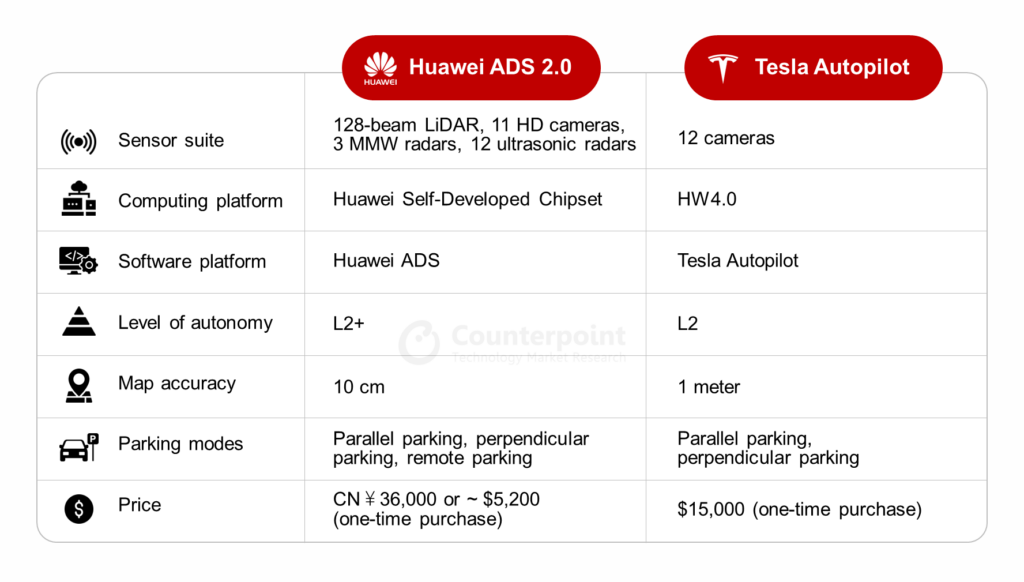- Huawei ADS 2.0 brings various improvements, particularly in driving experience and safety.
- Its enhanced hardware and new AI-powered features set it apart from competitors. Moreover, there is a timeline for NCA (Navigation Cruise Assist) to land in up to 45 cities in China by 2023.
- The main obstacle to Huawei ADS 2.0’s expansion in the domestic market is the lack of commercialization scale. For its global expansion too, Huawei faces challenges.
Huawei launched ADS 2.0, an AI-powered Advanced Driver Assistance System (ADAS), just before the Auto Shanghai exhibition in April 2023. In the same month, Counterpoint Research analysts attended the Huawei Analyst Summit 2023 while Senior Analyst Ivan Lam participated in Huawei Digi Salon, where a documentary was shown about Huawei ADS 1.0’s development and integration into the Arcfox Alpha S Hi model from BAIC. Interviews with the BAIC chief engineer and Huawei ADS engineer were featured in the documentary.
ADS 2.0 – Huawei’s major step forward
ADS 2.0 is a significant upgrade over Huawei’s first-generation autonomous driving system ADS 1.0. It has several new features and capabilities, including:
- Improved map accuracy: ADS 2.0 utilizes a new road network topology inference technology, which enables it to map its surroundings more accurately. This is crucial for safety, as it allows the system to better identify potential hazards. Besides, ADS 2.0 supports both high-speed NCA (Navigation Cruise Assist) and urban NCA without relying on high-precision maps. The company plans to promote its mapless (without High-Definition maps) ADAS in 15 cities in Q2 and 45 cities in Q4 of this year.
- Enhanced safety: ADS 2.0 has been trained on a massive dataset of real-world driving data, which has helped improve its safety performance. The system can now detect and avoid obstacles more effectively, and it is also better at handling unexpected situations. ADS 2.0 can now drive for up to 200 km without manual intervention, up from 100 km in ADS 1.0, making it more practical for everyday use.
- Human-like judgment and operation: With massive data training and AI-powered technology, the system demonstrates driving performance equal to that of an experienced driver, with a stable driving style that avoids excessive aggressiveness or conservatism for safety. It performs well in driving scenarios such as accurate turning, giving way to pedestrians, recognizing and avoiding irregular obstacles, as well as detecting and avoiding animals.
- More features: ADS 2.0 includes several new features, such as automatic and valet parking, making it easier and more convenient to use the car.
ADS 2.0 is enabled by both hardware and software upgrades. The system is powered by Huawei’s self-developed processor computing platform, which allows the system to process more data and make decisions more quickly. Meanwhile, more sensors are equipped to give the system a more complete view of its surroundings. Huawei benchmarked Tesla Autopilot as an important competitor.
Huawei ADS 2.0 vs Tesla Autopilot

Before ADS 2.0’s massive adoption in vehicles, the system has more advanced features than Autopilot, but its price may act as one of the obstacles to its popularity.
Commercialization
Although ADS 2.0 is a promising new ADAS in the market, there are some downsides and challenges to consider.
In China, there are four main groups of EV makers. The first group is made up of traditional car manufacturers such as SAIC Motor and GAC Group, which produce mostly budget to mid-range Evs without ADAS. However, most of these manufacturers are currently investing in ADAS companies as well as developing their ADAS systems in parallel. The second group consists of international vehicle giants, which will mainly use own ADAS systems in their cars. The third group, known as the “new car-maker forces”, includes companies like Nio, Xpeng Auto and Li Auto, which are pioneers in the EV industry and are developing their own ADAS systems and ecosystems like smart cockpits and smartphones. The last group consists of small to medium-sized car makers that produce cars ranging from entry-level to high-end.
Therefore, when Huawei announced again that it would not make cars or use the Huawei brand directly in any cooperation, it meant that it had fewer options. After a series of adjustments, Huawei’s smart auto business has three approaches:
- Traditional parts supplier model: Huawei provides standardized components to manufacturers under a buyer-seller relationship.
- HI business model: Huawei integrates software and hardware related to smart car solutions with automaker partners, including BAIC ARCFOX and Changan Avatr.
- Huawei’s Smart Selection business model: Huawei is deeply involved in product concept, vehicle design and channel sales, and works with car companies at the brand marketing level. “Aito” is an example.
With the current cost level of ADS 2.0, there will be fewer and only high-end cars equipped with this advanced ADAS. As regards its global expansion, Huawei is still in a sensitive position as this ADAS is powered by Huawei Cloud. Data privacy concerns about Huawei Cloud from foreign enterprises will be a potential hurdle. Nevertheless, it is still too early to make any judgment since China is currently the biggest EV market in the world. Huawei is keen to have its footprint across the industry as a supply chain player.
Outlook
Huawei put one-quarter of its revenue in 2022 into R&D for the whole group. The launch of ADS 2.0 shows that the company will continue with its strategies for the automotive business, including auto parts manufacturing, HI (Huawei Inside) and Smart Selection. The strong domestic market will be the stepping stone for Huawei’s automotive business growth. For instance, its cooperation with BAIC for the Arcfox Alpha S Hi showcases its competence in the high-end market.
Nevertheless, Huawei will face pressure to take ADS 2.0 to the next level of success because of the limit of its possibility to penetrate more vehicles. It will take time to prove ADS 2.0’s performance to the consumers. Besides, the cost of ADS 2.0 and its role will further threaten its expansion.

